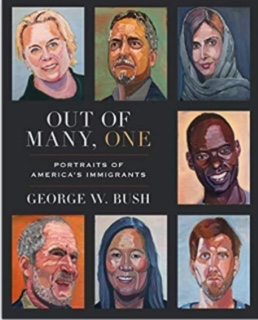
In his retirement, former president George W. Bush has famously taken up painting. His first collection was titled “Portraits of Courage, a collection of oil paintings and stories honoring the sacrifice of America’s military veterans.” His latest work is titled Out of Many, One and is a series of portraits of people who have immigrated to the United States. In an article published in the Washington Post, Bush writes that he had two goals for this series: “to share some portraits of immigrants, each with a remarkable story I try to tell, and to humanize the debate on immigration and reform.”
In the Post article, Bush says he’ll leave specific immigration policies to current political leaders. But then goes on to outline exactly what he thinks should be done in 6 parts. Let’s take a look at each of his ideas.
- Bush advocates for a path to citizenship for Dreamers. Well, this is low-hanging fruit. He feels like this is an easy place for agreement and it is, with the majority of the country supporting this. But then he goes on to argue that Dreamers should be granted a path to citizenship because “they ought not be punished for choices made by their parents.” Ugh, Bush, really. You had to throw that line in, didn’t you? So, there you have it. Dreamers are good immigrants. Their parents are bad ones. Dreamers shouldn’t be punished, but the implication is their parents should. Their parents are human beings who risked everything to try and provide a life for themselves and their children. Yes, their children had no choice. But one could argue that their parents felt they had no other choice as well.
- His next point is the need for a secure and efficient border. He advocates for “all the necessary resources — manpower, physical barriers, advanced technology, streamlined and efficient ports of entry, and a robust legal immigration system — to assure it.” Hmmm. Ok. I definitely agree with a robust legal immigration system (I’d add a robust, fair, legal immigration system). I also support streamlined and efficient ports of entry. Physical barriers and advanced technology? Have we not seen that border walls don’t work like when kids are being dropped over the wall? Or when tunnels are dug beneath them? The ever-increasing militarization of our border just leads to more human rights violations, deaths of migrants, and to one the most dangerous border between two countries NOT at war in the world. "Advanced technology," in this context — from facial recognition programs to drones — turns out to be little more than a euphemism employed to legitimize increased state surveillance behind a veneer of ostensibly respectable innovation.
- His third point is that we need to “work with our neighbors to help them build freedom and opportunity so their citizens can thrive at home.” Yes!!! Let’s address root causes of migration. Trump’s presidency did nothing if not prove that horrific conditions here and at the border do not prevent people from trying to come to the US. Why is that? Perhaps because no amount of deterrence can trump (pun intended) desperate conditions in home countries. But what does it look like to help build freedom and opportunity? Supporting an authoritarian president whose term has ended like Jovenal Moise in Haiti? Imposing sanctions, as in Nicaragua? Supporting known drug traffickers like Juan Orlando Hernandez in Honduras?
- Bush also suggests modernizing our asylum system. He says we need a “system that provides humanitarian support and appropriate legal channels for refugees to pursue their cases in a timely manner. The rules for asylum should be reformed by Congress to guard against unmerited entry and reserve that vital status for its intended recipients.” Yes!! Ok, we agree on something. The system has to start recognizing that people seeking asylum aren’t just fleeing persecution based on religion, race, ethnicity or politics. There is a large, and growing, number of migrants fleeing home countries because of climate change. Our definitions of refugee and asylum need to expand to respond to current realities.
- Increased legal migration, guest workers, etc. A point of agreement- if it is done equitably and fairly. You’ll excuse me if I’m doubtful.
- Lastly, he goes in hard against undocumented immigrants. All the same old arguments — “amnesty would be fundamentally unfair to those who came legally.” No, the system that allows some to come legally while others are forced to risk their lives to come “illegally” is unfair. He does say that undocumented immigrants should be brought out of the shadows with a gradual process to legal residency, so that’s something. But let’s stop acting like our current system is fair and some people are wrong for not playing by the rules.
He closes by saying “Over the years, our instincts have always tended toward fairness and generosity. The reward has been generations of grateful, hard-working, self-reliant, patriotic Americans who came here by choice. If we trust those instincts in the current debate, then bipartisan reform is possible. And we will again see immigration for what it is: not a problem and source of discord, but a great and defining asset of the United States.”
Wait — since when have our instincts tended toward fairness and generosity? The Chinese Exclusion Act? Ethnicity-based quota systems? In an excerpt from the book, Bush acknowledges the racist, biased history of our immigration system. But based on this article, he seems to have forgotten. If we trust our instincts we will end up right where we started. But I’ll agree with Dub-ya on one thing. Immigration is a “great and defining asset of the United States.” So let’s start there and build a new system actually built with fairness and generosity.


